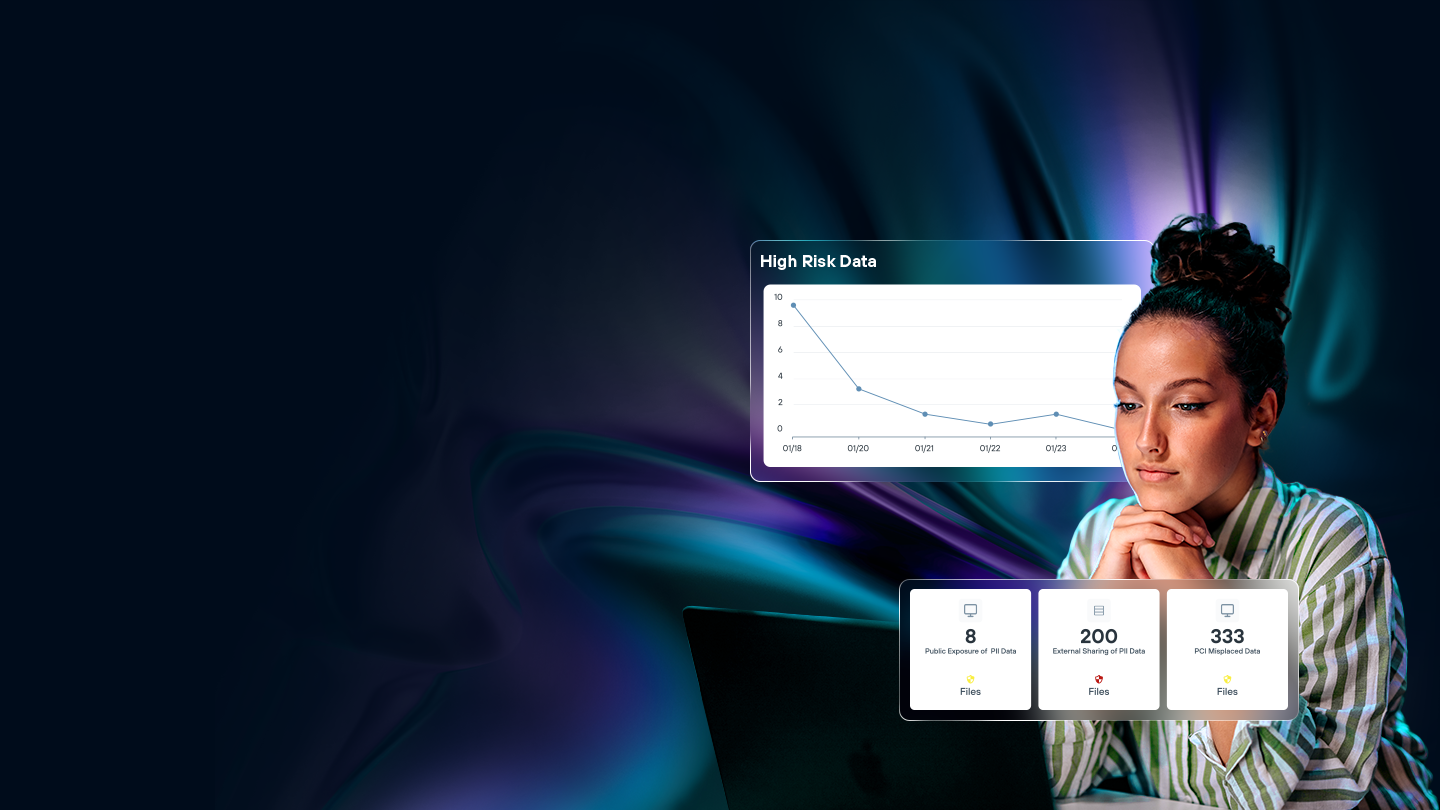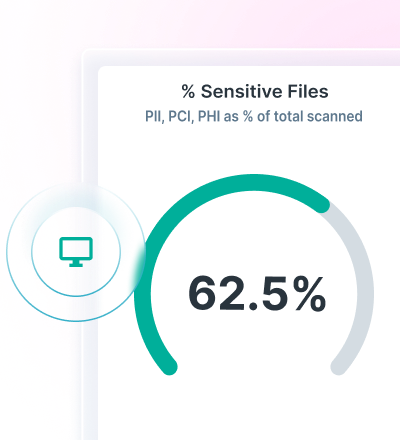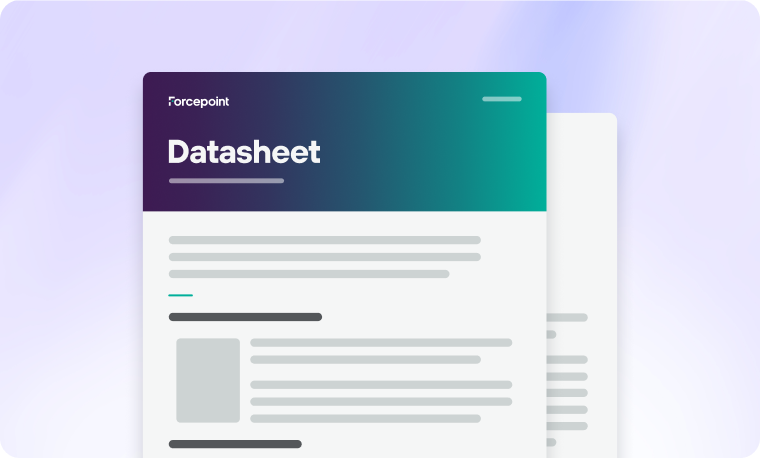
1.2万社以上のお客様に利用されています










































境界保護だけでは不十分。 ピンポイントの精度であらゆる場所のデータを保護します。
当社のData Detection & Response(DDR)ソフトウェアは、AIを活用した分類と継続的な監視を使用して、データ流出を動的に検出し、防止します。リスクを特定するだけでなく、修復の優先順位付けと加速を行います。
Forcepoint DDRは、企業を支援する最適なソリューションです。
潜在的なデータ侵害と内部脅威を検出し、対応します。
使用中の機密データを動的に保護
クラウドとエンドポイント全体にわたる広範な可視性を実現します。
侵害防止によるコスト削減


Forcepoint DDRの詳細を見る
当社のデータ検出&対応(DDR)ソフトウェアの動作をご覧ください。 プラットフォームのツアーをご覧になり、構造化データと非構造化データをどのように保護するかをご覧ください。
データ検出と対応ソリューションを使用する理由とは?
自信を持って分類可能
AIメッシュを使用してデータコンテキストを強化し、その固有の関連性と機密性を理解します。
脅威を早期に検出
ファイル共有、名前の変更、移動を継続的に監視することで、検出までの平均時間を短縮します。
エンドポイントとクラウドをカバー
クラウドとエンドポイントに可視性と適用を拡張し、広範な範囲をカバーします。
誤検知アラートを制限
重大度に基づいてアラートに優先順位を付け、対応時間を短縮します。


個人情報が危険にさらされていませんか?
データリスクアセスメントは、分類されていない機密ファイルから過剰に権限を与えられたユーザーまで、データに対する脅威を積極的に検出します。 Forcepointの無料のデータリスクアセスメントをリクエストし、DSPMの機能を確認し、データがどれほど安全であるかを確認します。


ビデオを視聴
ピンポイントの正確性と透明な報告を提供します。
FBD Insuranceの最高技術運用責任者(CTOO)であるEnda Kyne氏は、DSPMとDDRは重要なデータを制御し、規制当局に活動を報告する機能として、ITセキュリティチームとデータ保護チームから受け入れられていると述べています。
Forcepoint Data Detection & Responseを選ぶ理由




デジタル環境全体で24時間365日のデータアクティビティを監視します。 DDRは、ファイルアクセスパターン、共有行動、データ移動をリアルタイムで追跡し、機密データを制御から外れる前に、内部脅威を示す可能性のあるアクティビティをセキュリティチームに警告します。

Forcepoint DDRを強化する分類エンジンは、独自のAI Meshテクノロジーを使用して、高精度な分類を提供します。 AI Meshは、GenAI小規模言語モデル、ニューラルネットワーク分類子、予測AI、その他のデータコンポーネントのブレンドを使用し、精度を向上させます。

Forcepoint DDRは、Forcepoint DSPMのアドオンとして構成できます。 これらが組み合わされ、組織全体をカバーする継続的な識別、分類、脅威防止が提供されます。
DDRのお客様が語っていること
DDRのお客様が語っていること
よくある質問
What are the business benefits of DDR?
Forcepoint DDR helps prevent costly data breaches by detecting real threats earlier and focusing teams on the highest-risk events, which reduces incident impact, investigation time, and overall security operations cost.
It also increases confidence in digital transformation – cloud adoption, remote work, and AI/GenAI use – by providing continuous visibility into sensitive data and clear reporting that supports executive, customer and regulatory requirements.
Why is DDR important?
Forcepoint Data Detection and Response (DDR) is important because it continuously monitors how sensitive data is actually used across endpoints and cloud environments so you can spot and stop indicators of a breach while they’re happening, not months later. Traditional controls often leave a “visibility gap” around data-in-use. DDR closes that gap with real-time monitoring, AI-powered classification and automated responses to suspicious activity. It combines context from data, user behavior and permissions to reduce attacker dwell time, mitigate insider threats and prevent data exfiltration.
How does DDR detect threats or risky behavior?
Forcepoint DDR detects threats by continuously analyzing data events such as reads, views, creations, permission changes, renaming and sharing activities. It rescans items when significant changes occur and evaluates for anomalies and policy violations that indicate misuse, insider threats, compromised accounts or emerging exfiltration patterns.
Forcepoint AI Mesh adds context to distinguish normal business use from risky actions, then generates prioritized alerts and recommended or automated remediation steps to help security teams respond before data leaves your control.
How fast can DDR detect data exfiltration attempts?
DDR is designed for continuous, near-real-time monitoring and alerting. It tracks file access, movement and sharing 24/7 and raises alerts as soon as relevant risky events are observed and evaluated.
DDRは組織がデータ損失を防止し、脆弱性に対処するのをどのように支援しますか?
Forcepoint DDRは、事前定義済みのテンプレートをサポートし、PII、PCI、PHIなどの機密データへの漏洩を検出します。 これらのテンプレートは、継続的な監視と詳細なデータ履歴により、監査とコンプライアンスレポートを簡素化します。
Can DDR prevent data leaks in cloud apps?
Yes. Forcepoint DDR extends monitoring and protection to supported cloud and SaaS environments, using AI-powered classification and continuous analysis of file activities (such as uploads, shares, and permission changes) to detect and help prevent data exfiltration.
Does DDR use AI in its threat-detection capabilities?
Yes. The classification system in Forcepoint DDR is powered by AI Mesh, which provides high accuracy, a better understanding of context, and risk scores across monitored environments. This AI-native approach improves detection quality (fewer false positives, better prioritization) and enables automated or guided responses to suspicious data activity, making DDR materially more effective than static rule-only monitoring.
What types of data does DDR monitor and protect?
Forcepoint DDR monitors both structured and unstructured data, with specific focus on sensitive information such as PII, PHI and PCI data, as well as business-critical intellectual property. It tracks data across supported cloud and endpoint sources, following how files and records are created, accessed, modified, renamed, shared, or deleted. Using its proprietary AI Mesh data classification, it continuously identifies and prioritizes at-risk data wherever it resides.
Forcepoint DDRは他のセキュリティツールとどのように統合されていますか?
Forcepoint DDRは、Forcepoint DSPMソリューションの重要なアドオンであり、使用中のデータを継続的に監視します。 Forcepoint DSPMとDDRをForcepoint DLPと組み合わせることで、データがどこに存在していても、アクセス方法がどのように変わっているかを問わず、データを保護する総合的なデータセキュリティエコシステムが構築されます。 Forcepoint DDRは、Webhookを通じてSIEMおよびSOARソリューションとシームレスに統合し、インシデント対応と脅威管理を改善します。
What does DDR solve that DLP and SIEM don’t do?
Forcepoint DDR focuses on data-in-use and data behavior, delivering continuous monitoring, rich context and dynamic response where traditional DLP and SIEM have blind spots. DLP is optimized to enforce policies on data-in-motion (email, web, endpoints, etc.), and SIEM aggregates logs and alerts from many systems. DDR adds deep, AI-driven understanding of sensitive data and its lineage plus targeted response actions across clouds and endpoints. DDR enhances DLP and SIEM, augmenting them with highly accurate, context-centric intelligence and automating remediation when suspicious activities begin to take place. In combination, the three tools form the foundation for an effective data security strategy.
How does DDR support compliance and auditing?
Forcepoint DDR supports compliance by continuously monitoring exposure of regulated data such as PII, PHI, and PCI, using predefined detection templates and AI-driven classification aligned to common privacy and industry frameworks. This ensures faster identification of non-compliant data handling across monitored sources.
For auditors and regulators, Forcepoint DDR maintains detailed histories of data activities and risk events, enabling transparent reporting on who accessed what, how data moved, and which remediation actions were taken. This directly supports audits for GDPR, HIPAA, PCI DSS, CCPA and similar mandates.
Forcepoint DDRは、グローバルデータ保護規制への準拠をどのようにサポートしますか?
DLPは、複数のツールを使用してIT環境内の機密情報を特定し、組織内外のデータフローを監視し、セキュリティポリシーに基づいて機密データの組織外への流出をブロックします。













